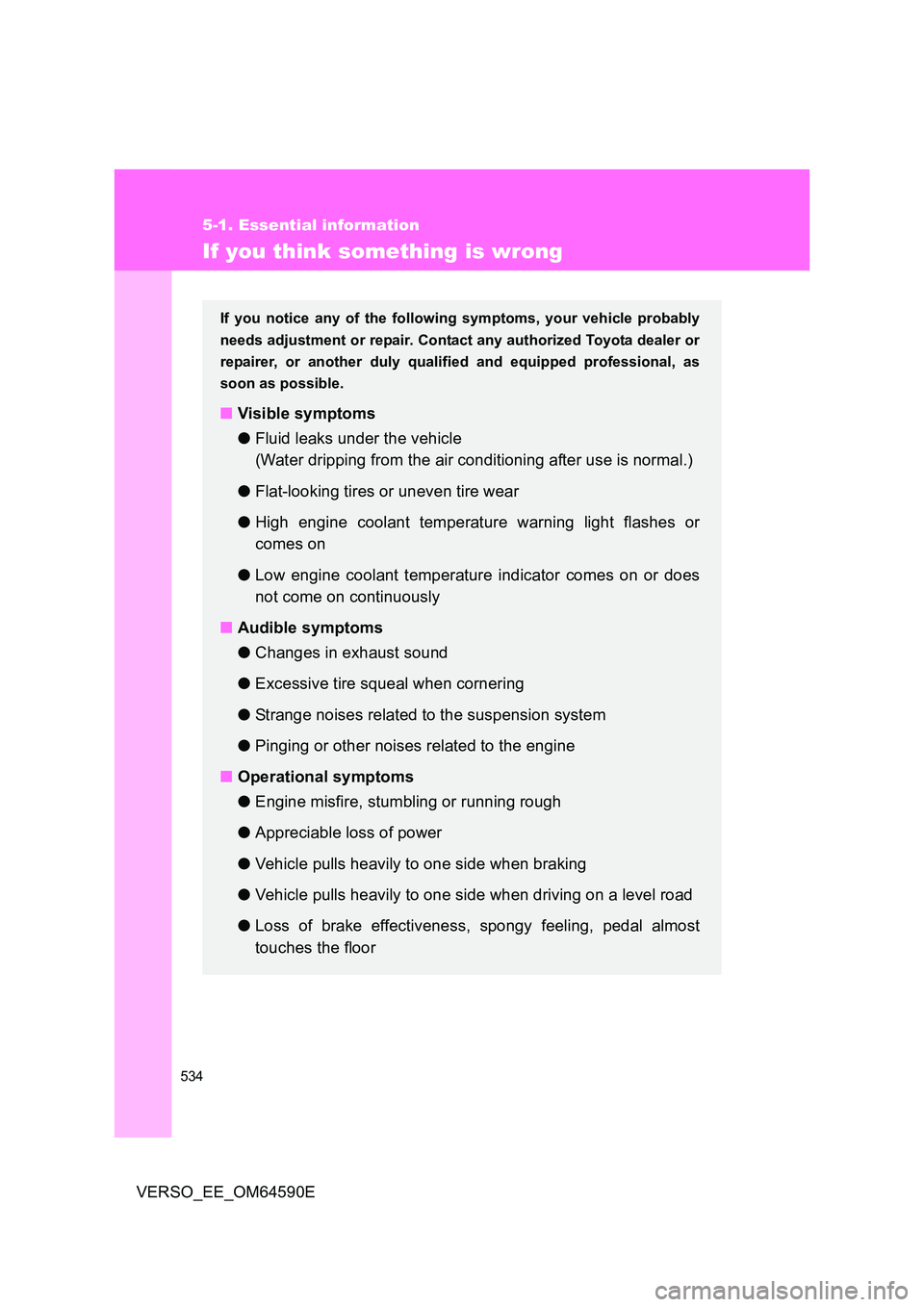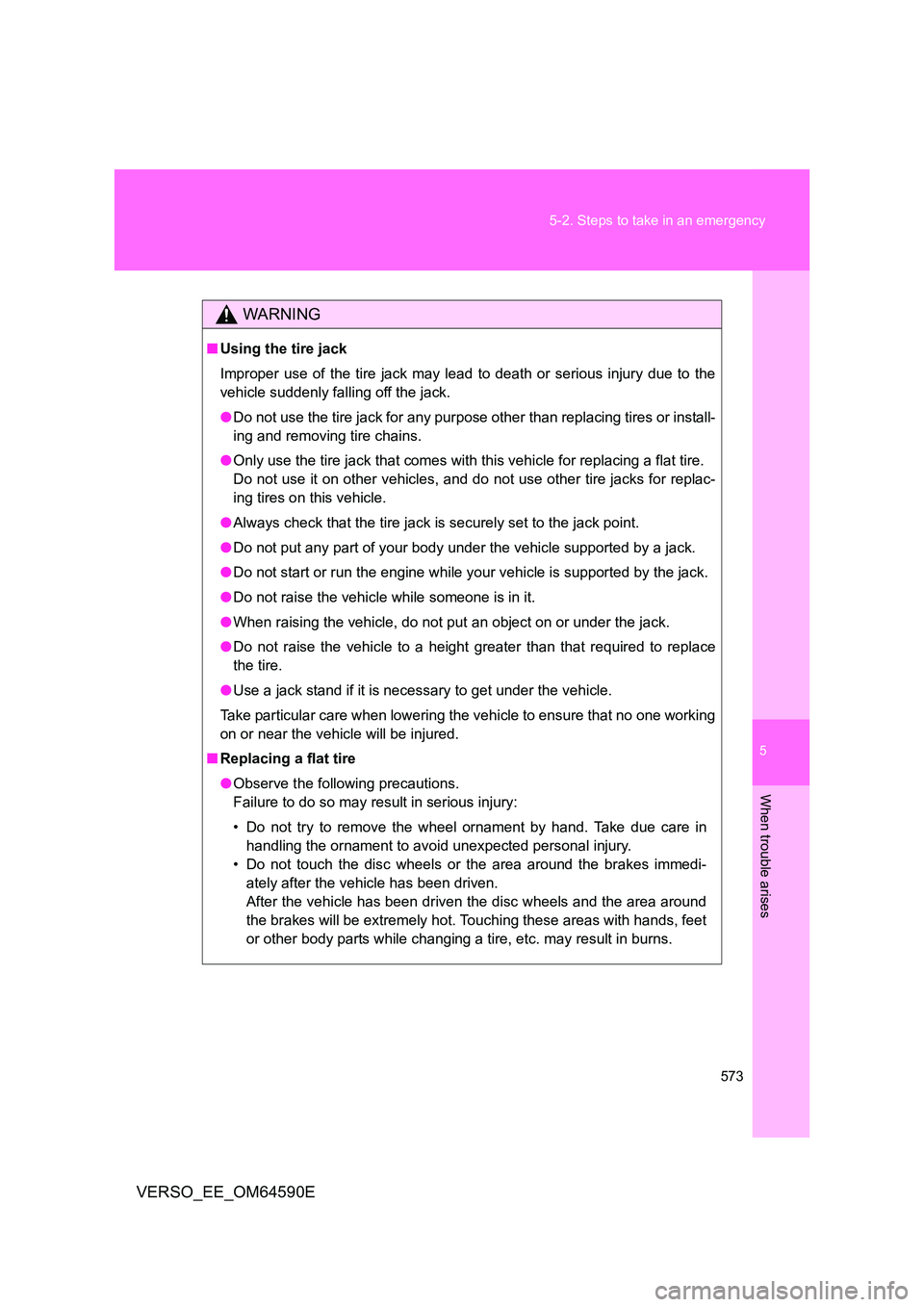Page 281 of 664

281
2-4. Toyota Safety Sense
2
When driving
VERSO_EE_OM64590E
● When the vehicle leans to one side an unusual amount due to a heavy
load or improper tire inflation pressure
● When the following distance between your vehicle and the vehicle ahead
is extremely short
● When the lane markers are yellow (These may be more difficult for the
system to recognize compared to white markers.)
● When the lane markers are broken, Botts’ dots (raised pavement mark-
ers) or stones
● When the lane markers are on a curb etc.
● When lane markers are obscured or partially obscured by sand, dirt, etc.
● When there are shadows on the road running parallel with lane markers,
or if a shadow covers the lane markers
● When driving on a particularly bright road surface, such as concrete
● When driving on a road surface that is bright due to reflected light
● When driving in a location where the light level changes rapidly, such as
the entrance to or exit from a tunnel
● When sunlight or the headlights of oncoming vehicles are shining directly
into the camera lens
● When driving on roads that are branching or merging
● When driving on a road surface that is wet due to rain, previous rainfall,
standing water, etc.
● When the vehicle experiences strong up-and-down motion such as when
driving on an extremely rough road or on a seam in the pavement
● When headlight brightness at nighttime is reduced due to dirt on the
lenses, or when the headlights are misaligned
● When driving on winding roads or roads that are uneven
● When driving on rough or unpaved roads
● When the windshield is dirty, or if raindrops, condensation or ice are
adhering to the windshield
● When the heater is blowing to the feet, the upper part of the windshield
may get fogged up and have a negative effect
● When cleaning the inside of the windshield, touching the lens or getting
glass cleaner on the lens may have a negative effect
Page 527 of 664
5
527
5-1. Essential information
When trouble arises
VERSO_EE_OM64590E
If your vehicle needs to be towed
Situations when it is necessary to contact dealers before towing
The following may indicate a problem with your transmission. Contact
any authorized Toyota dealer or repairer, or another duly qualified
and equipped professional or commercial towing service before tow-
ing.
● The engine is running, but the vehicle does not move.
● The vehicle makes an abnormal sound.
Towing with a sling-type truck
Do not tow with a sling-type truck
to prevent body damage.
If towing is necessary, we recommend having your vehicle towed by
any authorized Toyota dealer or repairer, or another duly qualified
and equipped professional, such as or commercial towing service,
using a wheel-lift type truck or a flatbed truck.
Use a safety chain system for all to wing, and abide by all state/pro-
vincial and local laws.
Page 534 of 664

534
5-1. Essential information
VERSO_EE_OM64590E
If you think something is wrong
If you notice any of the following symptoms, your vehicle probably
needs adjustment or repair. Contact any authorized Toyota dealer or
repairer, or another duly qualified and equipped professional, as
soon as possible.
■ Visible symptoms
● Fluid leaks under the vehicle
(Water dripping from the air conditioning after use is normal.)
● Flat-looking tires or uneven tire wear
● High engine coolant temperature warning light flashes or
comes on
● Low engine coolant temperature indicator comes on or does
not come on continuously
■ Audible symptoms
● Changes in exhaust sound
● Excessive tire squeal when cornering
● Strange noises related to the suspension system
● Pinging or other noises related to the engine
■ Operational symptoms
● Engine misfire, stumbling or running rough
● Appreciable loss of power
● Vehicle pulls heavily to one side when braking
● Vehicle pulls heavily to one side when driving on a level road
● Loss of brake effectiveness, spongy feeling, pedal almost
touches the floor
Page 573 of 664

5
573
5-2. Steps to take in an emergency
When trouble arises
VERSO_EE_OM64590E
WARNING
■ Using the tire jack
Improper use of the tire jack may lead to death or serious injury due to the
vehicle suddenly falling off the jack.
● Do not use the tire jack for any purpose other than replacing tires or install-
ing and removing tire chains.
● Only use the tire jack that comes with this vehicle for replacing a flat tire.
Do not use it on other vehicles, and do not use other tire jacks for replac-
ing tires on this vehicle.
● Always check that the tire jack is securely set to the jack point.
● Do not put any part of your body under the vehicle supported by a jack.
● Do not start or run the engine while your vehicle is supported by the jack.
● Do not raise the vehicle while someone is in it.
● When raising the vehicle, do not put an object on or under the jack.
● Do not raise the vehicle to a height greater than that required to replace
the tire.
● Use a jack stand if it is necessary to get under the vehicle.
Take particular care when lowering the vehicle to ensure that no one working
on or near the vehicle will be injured.
■ Replacing a flat tire
● Observe the following precautions.
Failure to do so may result in serious injury:
• Do not try to remove the wheel ornament by hand. Take due care in
handling the ornament to avoid unexpected personal injury.
• Do not touch the disc wheels or the area around the brakes immedi-
ately after the vehicle has been driven.
After the vehicle has been driven the disc wheels and the area around
the brakes will be extremely hot. Touching these areas with hands, feet
or other body parts while changing a tire, etc. may result in burns.
Page 660 of 664
660
VERSO_EE_OM64590E
What to do if...
What to do if...
A tire puncturesP. 560, 577If you have a flat tire
The engine does not start
P. 594If the engine will not start
P. 124Engine immobilizer system
P. 603If the vehicle battery is discharged
The shift lever cannot be
moved outP. 597If the shift lever cannot be shifted
from “P”
The high engine coolant temperature warning light (Red) flashes or comes on
Steam can be seen coming
from under the hood
P. 607If your vehicle overheats
The key is lostP. 598If you lose your keys
The battery runs outP. 603If the vehicle battery is discharged
The doors cannot be lockedP. 7 3Side doors
P. 7 9Back door
The horn begins to soundP. 137Alarm
The vehicle is stuck in
mud or sandP. 6 1 1If the vehicle becomes stuck